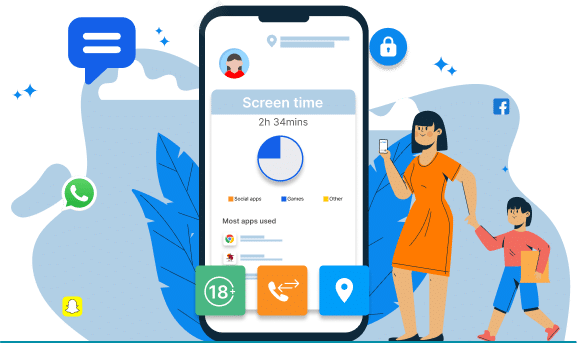
There is a massive increase in cyberbullying right now. Cyberbullies have picked on more than 50% of all kids, and some online groups for adults are also especially at risk. Patterns show that those numbers will probably go up, and Instagram is where it happens the most.
Your teen may scroll during school breaks, but texts that disappear and methods that are hard to find can put them in danger that you won’t see from the couch. Parents need clear, readable data about the dark side of Instagram, which is where Instagram monitoring with TiSPY comes in.
What Is the “Dark Side” of Instagram?
The smooth look of Instagram hides a confusing duality. On good days, Instagram encourages creation, community, and learning. On bad days, the positive and negative effects of Instagram come together in one endless scroll. Teenagers deal with harmful comparisons of their bodies, cyberbullying that looks like friendly chat, and “like” counts that make them feel good about being shallow.
Instagram’s algorithm-driven Reels keep teens engaged with an endless stream of personalized content, while vanish-mode chats allow conversations to disappear after viewing, making it harder for parents to detect potential risks. Some studies show that these habits can lead to anxiety, sadness, and a loss of self-worth. Instagram is built to increase user engagement, but this design can unintentionally expose teens to content and interactions that may affect their emotional well-being and safety.
Instead of restricting everything, parents need reliable tools that allow them to understand how their teens use Instagram. With clear insights, they can respond to potential dangers before they escalate.
Mental Health & Emotional Effects on Teens

At 11 p.m., Maya’s mom thinks her daughter is studying, but Maya is really just scrolling through highlight reel bodies and inside jokes. Dopamine levels rise with each like, but soon after, worry sets in: “Why don’t I look like that?” What if I miss the trend tomorrow?
This process makes people anxious, keeps their adrenaline levels high, and keeps them from sleeping, which makes them irritable, which their parents mistake for normal teen moodiness.
Constant comparison hurts self-esteem over time, which can lead to sadness and withdrawal. Without open communication and prompt parental support, these are typical social media negative effects on mental health that go unnoticed.
Hidden Features That Allow Teens to Hide Activity
The new settings on Instagram make privacy easy:
- Vanish Mode: Messages delete themselves when the chat ends. It stops photos and leaves no evidence for parents to look at later when they look through their phones.
- Finstas (Fake Accounts): Hidden profiles hide behind usernames that are hard to remember. It lets kids post more sensitive material without their families seeing it.
- Close Friends Stories: Some story lists only let trusted friends see them, so pictures that might be inappropriate never make it to the public or family feeds.
- Disappearing Media & Follower Controls: Temporary pictures, secret friends, and muted contacts make it hard to connect with others. It lets dangerous relationships grow without anyone noticing.
A determined teen can clear proof in seconds, but TiSPY keeps message logs, finds new logins, and alerts you to strange follower spikes, even after content disappears.
How TiSPY’s Instagram Tracker Reveals the Truth
TiSPY is more than just a simple screen-timer. Its Instagram monitoring module gives you instant, private information:
- DM Insight: It saves and rebuilds whole direct message lines, including texts, images, voice clips, and links to other websites. It lets you understand tone, context, and possible red flags in real time, from afar, and without drawing attention to yourself.
- Media Capture: Every picture, video, or Reel shared secretly is saved and can be viewed even after being deleted. It helps make sure that proof of inappropriate pictures, efforts to groom someone, or dangerous threats is always available.
- Follower Radar: TiSPY allows parents to view who their child is interacting with on Instagram, helping identify unfamiliar contacts or repeated interactions that may require attention.
- Vanish Alerts: Finds when Vanish Mode is in use, saves messages about to disappear before they disappear, and sends quick alerts. To leave no digital trace, it lets parents see conversations that their kids are having.
- Hidden-Account Mapping: TiSPY helps monitor login activity and app usage, which can reveal if a child is accessing multiple accounts or using private features to hide their online behavior.
You can step in early, teach better habits, or get psychologists involved because all the info is in an easy-to-use dashboard. TiSPY is quiet, doesn’t use much power, and works better than simple parental-control apps that only limit time and don’t look for danger.
Tips for Parents to Keep Instagram Use Safe

Technology alone can’t replace honest conversation, but it makes it safer to be honest. You can build trust without sacrificing safety or freedom by taking these steps. Pair these good habits with TiSPY tools:
- Set up “screen debriefings” once a week where teens can talk about their favorite accounts and why they follow them.
- For example, don’t use your phone during family meals, sports, or rest to reset your attention.
- Talk to them about what makes them anxious and tell them that tailored feeds distort reality.
- Set an example of healthy use by limiting how much you scroll.
- Instead of using TiSPY’s Instagram monitoring reports as proof of what happened, use them to start a talk about your choices and the risks they pose.
Conclusion
Instagram can help you learn, be creative, and make friends. Without questioning their use, kids are open to forces and predators they can’t see. TiSPY gives parents the information they need to make better decisions by exposing the dark side of Instagram.
Get TiSPY’s Instagram tracker for your family right now. You can get a seven-day free trial and see exactly what your child sees, without the privacy. With knowledge, you can protect, teach, and encourage good digital habits for every page you read.



